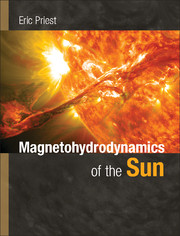Book contents
- Frontmatter
- Dedication
- Contents
- Preface
- 1 A Description of the Sun
- 2 The Basic Equations of Magnetohydrodynamics (MHD)
- 3 Magnetohydrostatics
- 4 Waves
- 5 Shock Waves
- 6 Magnetic Reconnection
- 7 Instability
- 8 Dynamo Theory
- 9 Magnetoconvection and Sunspots
- 10 Heating of the Upper Atmosphere
- 11 Prominences
- 12 Solar Flares and Coronal Mass Ejections
- 13 The Solar Wind
- Appendix 1 Units
- Appendix 2 Useful Values and Expressions
- References
- Index
10 - Heating of the Upper Atmosphere
Published online by Cambridge University Press: 05 June 2014
- Frontmatter
- Dedication
- Contents
- Preface
- 1 A Description of the Sun
- 2 The Basic Equations of Magnetohydrodynamics (MHD)
- 3 Magnetohydrostatics
- 4 Waves
- 5 Shock Waves
- 6 Magnetic Reconnection
- 7 Instability
- 8 Dynamo Theory
- 9 Magnetoconvection and Sunspots
- 10 Heating of the Upper Atmosphere
- 11 Prominences
- 12 Solar Flares and Coronal Mass Ejections
- 13 The Solar Wind
- Appendix 1 Units
- Appendix 2 Useful Values and Expressions
- References
- Index
Summary
Introduction
Understanding how the chromosphere is heated to 104 K and the corona to 106 K, by comparison with the photosphere at 6,000 K, is a major challenge in astronomy (Klimchuk 2006; Reale 2010; Parnell and De Moortel 2012). Coronal heating is only a few per cent of chromospheric heating, so a comprehensive model needs to treat the generation, propagation and dissipation of energy through the whole atmosphere. This includes the continual transfer to and fro of mass and energy between chromosphere and corona and the fact that transition-region plasma is material that happens to be heating up and cooling down dynamically through 105 K.
Although the present chapter focuses mainly on coronal heating, many of the principles also apply to the chromosphere and some mechanisms work even more effectively there: for example, the tectonics model generates more heat low down in the atmosphere, where the magnetic field is stronger and more complex (Sec. 10.4.5). Until the space age, the main way of viewing the Sun's outer atmosphere was during a solar eclipse (Figures 1.21 and 10.1), when the corona appears with beautiful structures dominated by the magnetic field. Since then, great progress has been made in coronal observations from space, in refining the questions about the nature of the corona, and in proposing viable models.
- Type
- Chapter
- Information
- Magnetohydrodynamics of the Sun , pp. 334 - 390Publisher: Cambridge University PressPrint publication year: 2014



